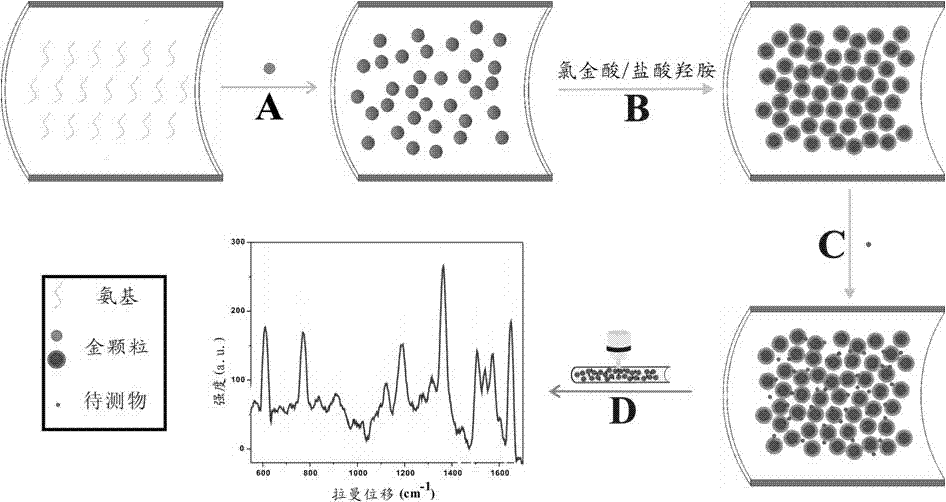Surface-enhanced Raman scattering spectroscopy detection method based on capillary
A surface-enhanced Raman and detection method technology, applied in the field of analysis and detection, can solve the problems of complex SERS substrate preparation process and expensive equipment, and achieve the effects of shortening the detection time, real-time on-site detection, and avoiding detection steps
- Summary
- Abstract
- Description
- Claims
- Application Information
AI Technical Summary
Problems solved by technology
Method used
Image
Examples
Embodiment 1
[0036] Decorate gold particles on the inner wall of the capillary and detect the Raman enhancement effect of the gold particle-modified capillary:
[0037] In this experiment, the inner wall of the capillary was pre-hydroxylated, and then the treated capillary was immersed in 3-aminopropyl-trimethoxysilane (APTMS), so that the inner wall was modified with a layer of amino groups. The coordination between gold particles uniformly decorates its inner wall. Under the action of hydroxylamine hydrochloride and chloroauric acid, the gold particles gradually grow up to a suitable particle size and particle spacing (see image 3 ).
[0038] The SERS substrate obtained by this method uses R6G (chemical name rhodamine 6G) as the probe molecule, and its detection limit can reach 1 mmol / l. From Figure 4 It can be seen that when ethanol solutions with different concentrations of R6G are detected with 514nm excitation light under the Raman spectrometer, as the concentration of R6G decre...
Embodiment 2
[0040] Silver particles are modified on the inner wall of the capillary and the Raman enhancement effect of the capillary modified by Ag particles is detected:
[0041]Under the action of boric acid and ammonium hexafluorotitanate, a thin layer of titanium dioxide can be pre-deposited on the inner wall of the capillary, and then the capillary is immersed in an aqueous solution of stannous chloride, so that a layer of divalent tin ions is adsorbed on the surface of titanium dioxide. In this way, when the capillary is immersed in the silver ammonia solution, a layer of silver particles can be uniformly grown on the inner wall in situ through the reduction of divalent tin ions, thereby having the SERS effect (see Figure 5 ).
[0042] R6G was also used as a probe molecule to study the Raman enhancement effect of Ag particle-modified capillaries, and the results showed that 10 -5 The R6G ethanol solution of mol / L can produce stronger SERS signal under the Raman spectrometer with ...
Embodiment 3
[0044] SERS characterization of other organic pollutants in ethanol solutions using gold particle-modified capillaries as the SERS substrate:
[0045] The capillary decorated with gold particles was used as the SERS substrate, and the 10 -5 mol / L other organic pollutants 4-ATP (p-mercaptoaniline) and Paraoxon (ethyl paraoxon) were simulated on-site detection. Figure 7 , Figure 8 They are the detection results of 4-ATP and Paraoxon respectively. The specific operation method is to directly inhale the ethanol solution of the analyte into the capillary, and use 514nm excitation light to detect under the Raman spectrometer. The results showed that the SERS signal was strong, indicating that the SERS active substrate had wide applicability.
PUM
 Login to View More
Login to View More Abstract
Description
Claims
Application Information
 Login to View More
Login to View More - Generate Ideas
- Intellectual Property
- Life Sciences
- Materials
- Tech Scout
- Unparalleled Data Quality
- Higher Quality Content
- 60% Fewer Hallucinations
Browse by: Latest US Patents, China's latest patents, Technical Efficacy Thesaurus, Application Domain, Technology Topic, Popular Technical Reports.
© 2025 PatSnap. All rights reserved.Legal|Privacy policy|Modern Slavery Act Transparency Statement|Sitemap|About US| Contact US: help@patsnap.com



